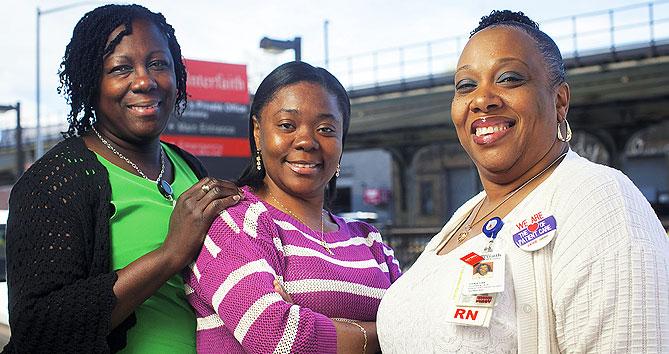A volume of voices together

“We’re defying expectations,” says Sharon Bedford about the reprieve that will keep Interfaith Medical Center in central Brooklyn open through March 2015 while our coalition pursues a lasting solution to the hospital’s chronic underfunding. Sharon is an RN at Interfaith and membership chairperson of the local bargaining unit: “We have been through so many emotions. Keeping the hospital open is a significant achievement on the coalition’s part.”
It took hard work, and lots of it, to make this happen: weekly rallies; letters, calls, petitions, and visits to city and state legislators; the participation of NYSNA members from other facilities; leafleting at nearby subway stops; community events; and forming a new kind of partnership with other healthcare unions, the community, and elected officials.
RNs on the front lines
Last summer, Bill de Blasio’s mayoral race made keeping Brooklyn hospitals open a key campaign issue citywide. And this winter, the production of Edward Albee’s play “The Death of Bessie Smith” at Interfaith brought international attention to the struggle to protect access to healthcare in low-income communities of color.
But it’s nurses like Sharon Bedford, Charmayne Saddler-Walker, and Christine Toomer who have been on the front lines for more than a year fighting to save the hospital.
“Somewhere along the line,” notes Sharon, “it went from hospital employees trying to save their jobs to we really need to keep this place open because the community depends on us and if we are not here who is going to take care of them? It went from making a positive impact in the life of one person to impacting the life of the community.”
“The demand is great,” says Charmayne of the community’s need for the hospital. Interfaith is not a public hospital, but it turns no one away and the majority of its patients are uninsured or underinsured. “We see asthmatic patients from pediatrics up, diabetes, heart disease, sickle cell,” says Christine. “Patients ask me, ‘If you close, where am I going to go?’”
“Our success so far gives us hope that by being persistent and keeping our eyes on the goal, we’ll be able to achieve the best for Interfaith,” says Charmayne. “We’re working together in a new way with other unions, and with elected officials and community members, and looking at the community’s needs. What should Interfaith look like in the future?”
Creating a model
The bankruptcy court has appointed a chief restructuring officer and Interfaith has a new CEO. “As part of the joint task force with 1199, we’re conducting a survey,” says Sharon. “We want at least two-thirds of staff to respond and tell us their major concerns. We are tallying the responses and making a list of the top 10 areas that are in need of improvement. Then we’ll come up with a plan.” At the same time, our coalition is continuing to develop a cooperative approach to funding and running Brooklyn hospitals.
“This healthcare issue can be used as a model,” thinks Sharon. “Now community leaders know how to mobilize the members of the community for a common goal and they’ve seen a path to follow to hold politicians accountable.” Christine adds, “It’s like a burden has been lifted. Yes, we’re open. As a group, we could achieve this.”
Empowering a community
“Our experience reminds me of someone making a quilt,” says Charmayne. “You start off with just one piece, but as you go, somehow unexpectedly you put a pattern together. It was like we were just one thread, but with everybody, it has become a fabric.”
What started as a fight to save a hospital has turned into something even more. “Saving Interfaith makes our community feel empowered,” concludes Charmayne. “It’s a lesson that irrespective of social status, your voice makes a difference. And a volume of voices together is power.”